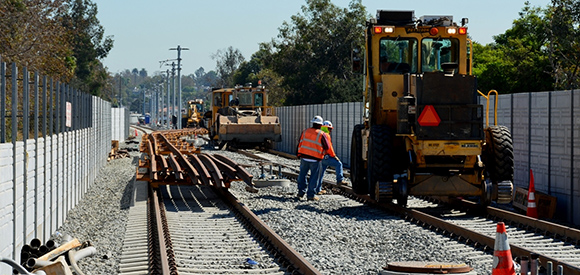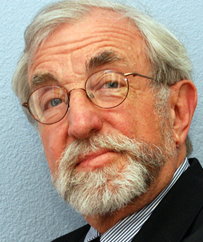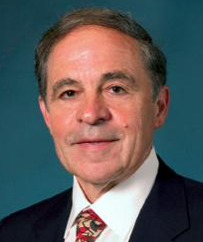
(Photo Credit: Metro Library and Archive)
Originally published in The Planning Report
Senate Bill 628, passed in the fall, created Enhanced Infrastructure Financing Districts—a new economic development tool intended to fill the “hole” that the dissolution of redevelopment agencies left in California. TPR spoke with two experts on the legislation: Fred Silva, Senior Fiscal Policy Advisor at California Forward, and Mark Pisano, USC Price professor and former Southern California Association of Governments executive director. They delve into the specific mechanisms of EIFDs, explaining the tool’s scope, structure, powers, and potential application across the state. For further information on EIFDs, see Holland & Knight’s 2014 analysis here.

Fred, Senate Bill 628, Enhanced Infrastructure Financing Districts, was signed by Governor Jerry Brown in September 2014 and took effect this January 1. You’re a legislative staff veteran, having crafted much of the legislation that affects California state and local finance. Summarize the takeaways from this legislation for our readers.
Fred Silva: This is a new approach that we have not seen before. It comes out of a specific problem in local finance: Most of the infrastructure and city-centered investment over the last 50 years has been done through the redevelopment process, which was a fairly narrow, old, urban-renewal-style system.
The Brown administration saw that much of redevelopment was financed through the state General Fund, using the school’s share of the property tax as a significant part of local redevelopment. They were looking for a broader form of financing local infrastructure that was not a burden on the state General Fund. The legislature was challenged to develop a broader set of authorities that were intergovernmental, so that cities, counties, and special districts could get together to meet local infrastructure needs, rather than the fairly narrow confines of the old redevelopment law.
This legislation came out of a year-long process involving local and regional civic leaders participating in the California Economic Summit, which is a partnership between California Forward and the California Stewardship Network (www.caeconomy.org). They said to the Brown administration and legislature, “We need a broader set of tools that allows cities, counties, special districts, and the private sector to invest in California’s infrastructure needs.” Out of that realization, the legislature enacted SB 628 by Senator Bell, and the governor signed it.
The legislation upgraded IFDs, a mechanism long in existence but rarely utilized. What’s the difference in scope between allowable facilities under IFDs and now EIFDs?
Fred Silva: Good question. The old model, invented in the 1980s, was intended to fill a gap after Proposition 13 was enacted that limited the levy of property taxes for a variety of purposes. The idea was to allow the growth in the property tax from non-school entities to be used in the same way that the redevelopment law was used.
The old Infrastructure Financing District Act was not used because the redevelopment powers occupied the field. The “redevelopment-industrial complex” of lawyers, public finance and economic development consultants had been built up over such a long period of time and simply found little use for the IFD statute since it did not provide access to the growth on the schools’ share of the property tax and therefore produced less revenue.
That was part of the rationale of having an Enhanced Infrastructure Financing District that does not use the school share of the property tax, but uses the total amount of property tax that a county, city, or special district uses, which would be available for capture as investment occurs and as the economy grows.
This was a matter of developing a broad set of tools beyond the old Infrastructure Financing Districts. You can use assessments for benefit here; you can use developer fees; you can facilitate regional infrastructure agreements. These powers are broadly cast so that communities can use that flexibility to invest in infrastructure.
Fred, Are EIFDs a worthy response to the demise of redevelopment?
Fred Silva: After the repeal of redevelopment, the tool of capturing growth in the property tax was basically eliminated. The choice facing the Economic Summit was: “Should we just put that Redevelopment Authority back, and not allow it to have access to the schools’ property tax?”
The answer was “no”—it should have broader authority. The amount of property tax subject to tax increment should be larger than the current allocated property tax the city gets. Without getting into the details of the property tax allocation system, this basically allows a community to take all of the property tax growth it’s getting not only from its statutory share of growth in assessed value, but also from the assessed value growth in community-wide property tax it gets from the Vehicle License Fee backfill, and set aside a portion for infrastructure investment.
The mayor of San Diego has indicated that he wants to take a piece of the incremental value in the property tax and dedicate it to infrastructure.
Mark, you’ve long been a critic of the old model—Community Redevelopment Agencies—and, you’ve been vocal in positively endorsing this new mechanism. But will the Enhanced Infrastructure Financing Districts be sufficient to fill the city tool-kit gap created by the loss of CRAs in the State of California?
 Mark Pisano: The answer is “yes.”
Mark Pisano: The answer is “yes.”
This statute combines all financing abilities in the state code (that we know about) and allows them to be integrated into a financial business plan developed by the board of the district, newly created Public Finance Authorities.
In doing so, you’ll create sufficient financial capacity—funding stream capacities—to do what the subdivisions of the state need to do in the future for economic development, environmental mitigation, and infrastructure. You can use the flexibility within the statute practically.
Let me add to Fred’s observation: The Infrastructure Financing Districts had a narrower scope regarding what they could undertake. This was expanded and was done by adding infrastructure and environmental mitigation to economic growth strategies, which increases wealth and value creation. This statute expands that scope to almost everything in the state, except school districts. They can invest in all of the infrastructure necessary to support growth, and furthermore, all the economic development activities that have public purposes and do environmental mitigation.
Mark, elaborate on why EIFDs are an important investment tool for cities.
Mark Pisano: First, an EIFD allows investment programs to achieve goals and allows beneficial uses to be integrated—rather than programmatic, grant, or stove-pipe investments. Integrating investments creates multiple revenue streams that can be brought together.
Next, investment packages will be able to take advantage of the multiple financing authorities and tools that are available to the Public Finance Authority: fees for beneficial services; and partnerships with both for-profit and non-profit organizations, which are permitted to collect these fees. Additionally, investing in infrastructure and changing your land-use policy will increase wealth that, in fact, can be captured and used by the financing authority through assessment financing and tax-increment financing.
These are all packaged together in the third leg of the stool: the capacity to bundle organizations that have these revenue streams together. They can be put together in a much more flexible way than the historic Joint Powers vehicle of the past. Through resolutions of governing bodies, they can elect to participate without having to go through a long, tortuous, rigorous process of putting together Joint Powers agencies. I’ve done a number of those in my career. They can be done, but they’re not easy to do.
Fred, you’re a veteran of the local and state public finance wars. How significant is the passage of SB 628 and implementation of EIFDs, in terms of rationalizing state and local finance?
Fred Silva: What’s important here is that we’re finally settling on having sufficient powers at the community level, particularly the multijurisdictional level, to capture economic growth and invest it in infrastructure. That is a very big deal.
Mark Pisano: Looking at the potential threshold value of this, it could have as much positive effect on how we grow, build, and develop our state as Prop 13 had a limiting effect.
Not that it’s going to enhance or increase taxes. EIFDs rely on the principle that, if you build something, it creates value. If you zone something, it creates value. Infrastructure also creates value. That value—because of the way the financing instruments have been arranged—can be captured. Individuals, corporations, and land all benefit from these investments and will now pay for them. You’re not taxing the general community. You’re saying that those who benefit can and should pay for what they use.
Could you provide an example of how EIFDs will enhance local government capacity to invest in desired infrastructure?
Mark Pisano: Right now, the LA River runs through the lowest-value property in LA County. We’ve made the LA River our industrial backyard.
I taught a studio in which my students went through the exercise I’m going to describe. If the river becomes more environmentally and aesthetically friendly through improvements, and if we change the land-use of the property surrounding the river, our case study shows that the appreciation of increased value of that property and the capture and use of the water in the river could substantially pay for the restoration of the river.
The EIFD would enable us to build new residential and commercial development along the river, and substantially help fund the investments that we need, particularly residential. Property along the waterfront in this state—particularly the coastal waterfront—is valuable. Think of what we could do with the poorest property in LA County, if the river is restored and becomes more valuable—which, in turn, can fund a lot of the infrastructure and mitigation.
The same is true of transit. We have found in study after study that, where you have transit, the value (both immediately and near transit) increases. Very seldom is that value captured and used for public purposes. That’s only beginning.
How might the City of Los Angeles capture the land value appreciation along the river?
Mark Pisano: In the City of LA’s Master Plan for the river, it identified 20 opportunity areas where new development could occur, where there could be upgrading and zoning of property. Furthermore, nine new transit stations would be located around, or along, the river. These opportunity areas and stations create value that can be captured through the financial instruments in this piece of legislation.
We’ve always thought of planning as a vision-setting process. Planning, and particularly Specific Plans, create a framework embodied in ordinances and in local law that establishes value. Planning, visioning, and investment also create wealth. We’ve never really captured that in the way we fund our local development. We’ve done some capturing through developer agreements and RDAs in blighted areas, but that’s basically it. We don’t really have refined instruments that allow us to capture this value.
Fred, could you provide an example from a city other than LA?
Fred Silva: There’s a good example in the City of San Jose, where the transit authority is working on extending BART from the East Bay and Fremont through downtown San Jose and then up to Santa Clara. It’s about a $4 billion project. They have $2 billion of it accounted for, in the form of a piece of the sales tax and aid from the federal government. But they’ve got about $2 billion they need to find.
Because they’re talking about the construction of four stations, which will generate economic activity, they can do two things. They can use assessments for benefit to attach assessments to those properties that are directly benefitted by the stations. They can also take a portion of the growth in the property tax that accrues to the city and the county and use it for the construction of the BART extension. This is one example in which you can both capture value through the property tax, and you can also assess a property based on the benefit they’re deriving from the improvement.
Mark Pisano: One valuable tool in an EIFD is the district’s board, which is called a Public Finance Authority. Those Public Finance Authorities establish the business plan that contains the assessments, the value capture, and the fee revenues that can be derived through either direct investments or partnership with the private sector. Finally, those Public Finance Authorities can be the recipient of state, federal, or local grants, funds, or tax credits. It’s the capacity to integrate both organizations and funding streams that is as much of an innovation in this statute as the packaging of the revenue sources.
Fred, can you elaborate on the law’s requirement that a strategic plan be created for EIFDs that incorporates all the funding streams and shows, for each project and property, a link between payer and beneficiary?
Fred Silva: This goes back to the question, “Should the state simply put redevelopment back?” We thought that, rather than simply using the old urban-renewal model, communities—in a public forum—should look at what their investment needs are and set up a business plan for investment. Communities should do that and then figure out how it ought to be financed—not figure out how to finance something before looking at the way in which you want the community to grow.
For example, the City of Martinez is considering setting up a citywide EIFD. They didn’t start with: “Shall we set up an EIFD?” They started with a citizens’ task force that looked at their infrastructure investment needs over the next 20 years. They’re just starting that process. Whether or not they conclude that an EIFD is useful, what’s important is that they’re going through a strategic planning process.
Mark, you must be proud of this new model for financing urban infrastructure projects. Talk a little about the frustrations with redevelopment law that contrast with your enthusiasm for EIFDs.
Mark Pisano: I observed over the last 10 years of my 32-year career that increasingly the planning we were doing did not have the resources for implementation—from local plans, to General Plans, to regional investment plans for infrastructure. Secondly, they did not have the resources to undertake the environmental mitigation. Too often in our Environmental Impact Statements, we have statements of overriding consideration that enable EISs and EIRs to be approved.
This EIFD process turns planning on its head. It’s not just about vision and goal-setting. Planning for growth, infrastructure and mitigation is made possible by the capacity to integrate the funding needed to make it real.
The process for EIFD approval says you’ve got to be able to demonstrate that there’s a funding stream and a business plan. That’s a sea change for the planning field.
Lastly, policy change does not happen without there being some pushback. SB 628 has now passed. Will there be arguments over implementation of the new tool?
Fred Silva: It isn’t so much about pushback as it is about getting local officials and those in the “infrastructure-industrial complex” to see the usefulness of the tools.
This is a new way of thinking. This is not an approach like redevelopment where the tax increment simply rolled into City Hall and they could do what they wanted with it. This approach says: You determine what those infrastructure needs are, you set up a financing plan for them, and these resources are available to that financing plan—not simply to help fund the city management office.
Mark Pisano: EIFDs and Public Financing Authorities are separate governmental entities. They will have their own boards, which will be established through membership—comprised of cities and counties, the affected taxing entities that can be added to the district, and public members.
The separate governmental entity has the capacity to access a lot of different statutory provisions. So you need to look at SB 628 in combination with a series of other statutes.
The bill refocuses how we put separate things that exist today together. By putting things together in a more effective way, we can get a substantial increase in synergy and in investments. We can get substantial cost-saving. You can look at lifecycle costs and make efficient resource-allocation decisions, to be coupled with planning decisions. Through this approach, we can grow the state without taxing ourselves in an uncompetitive way.
Republished with permission of the The Planning Report

